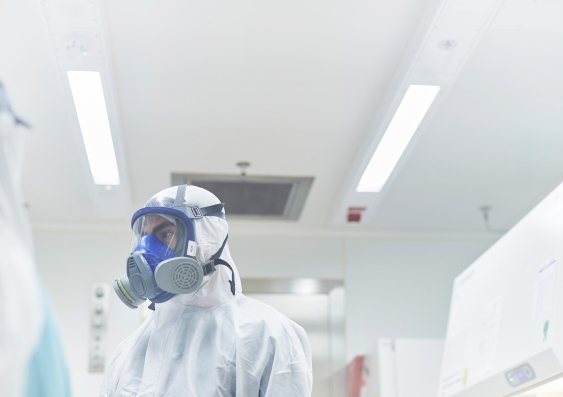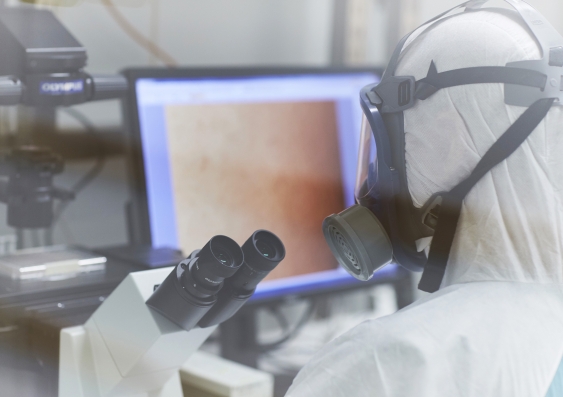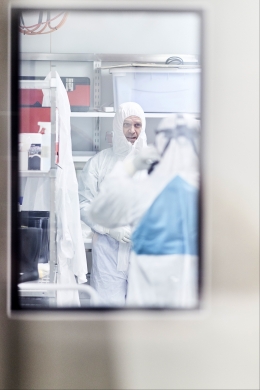Investigating the virus’ lifespan, creating safe virus lookalikes, and studying immunotherapy solutions are just some of the collaborative research projects happening in a high-level containment lab at UNSW Medicine’s Kirby Institute.

Alberto Ospina Stella in the Kirby Institute’s PC3 containment lab where he is working to grow the SARS-CoV-2 virus and determine how it responds to different treatments. Image: Richard Freeman / UNSW
Virologists, immunologists, and biologists have joined forces at UNSW Medicine’s Kirby Institute to study SARS-CoV-2, the virus which causes the disease COVID-19.
‘Is the virus mutating?’, ‘Can it be transferred through breast milk?’ and ‘How can we harness antibodies to fight the virus?’ are some of the questions these scientists are trying to answer.
The range of experiments aim to learn more about how the virus works while also contributing to global efforts to create therapies and treatments for COVID-19.
“We hope that some of our findings will be usable in the near future – that they’ll actually make a difference in real time,” says Conjoint Professor William Rawlinson, Senior Medical Virologist at UNSW.
Starting from scratch
The work is taking place in the Kirby Institute’s level three physical containment (PC3) lab – a secure facility built to contain infectious microorganisms. It is one of only a few labs in Australia cleared to work with the live SARS-CoV-2 virus.
Up until two months ago, the Kirby Institute was using the space to focus on HIV and hepatitis research. Within weeks, they retrofitted the lab to make it suitable for working with SARS-CoV-2.
“With limited tools and a newly emerging pathogen, there are a lot of fundamental things that we need to build from scratch,” says Kirby Institute researcher, Associate Professor Stuart Turville.
“Before developing virus treatments, we need stashes of reagents and virus samples. With SARS-CoV-2, we’re trying to build these things in real time.”
“Before developing virus treatments, we need stashes of reagents and virus samples. With SARS-CoV-2, we’re trying to build these things in real time.”
To fast-track these efforts, A/Prof Turville and Prof Rawlinson merged their teams to build stockpiles of the virus.
Samples of the virus are collected in hospitals directly from patients who have tested positive. These samples are securely transported to the lab where they’re processed and moved on to cell lines to feed on.
If the virus is happy, the cells will start to die – a process that takes around three or four days. Once this happens, the virus is removed from the cells, frozen down and stored in the facility.
If the virus starts to change during the incubation period, the new strains will be grown and stored separately.
“You can do all sorts of experiments once you have live virus,” says Dr Sacha Stelzer-Braid, a virologist at UNSW Medicine with expertise in respiratory viruses.
“We can test how long the virus survives, the conditions under which it best grows, whether new treatments work and, if so, whether they partially or completely kill the virus.”

Stuart Turville examining the SARS-CoV-2 virus through the microscope, with the image portrayed on the computer screen. Image: Richard Freeman / UNSW
Learning from the immune systems of survivors
Antibodies – proteins created by the immune system to fight bacteria and viruses – can be found in the blood plasma of people who have recovered well from the virus. When transfused to people who aren’t doing as well, the introduced antibodies can help fight the virus and give the patient’s body time to recover.
This style of therapy, called passive immunisation, is currently being explored as a potential therapy for COVID-19 patients. The project is being led at UNSW by the Kirby Institute’s Director, Professor Anthony Kelleher.
“We’re screening the blood of people who have recovered healthily from the virus to determine how active their antibodies are against the virus,” says A/Prof Turville.
By screening the antibodies, the team will learn if the antibodies bind to the outside of the virus and how well they can block the virus in the laboratory.
“This knowledge enables our team to develop a plasma-derived therapy for treating people with serious COVID-19 complications,” says A/Prof Turville.
The Kirby Institute is also working on another antibody-based collaboration with . They are investigating whether monoclonals – lab-made molecules engineered to work as substitute antibodies – could be used in potential therapies.
If a viable treatment option is discovered in the lab via either of these methods, the Kirby Institute will test in the real world through its clinical trials program.
A virus ‘lookalike’ for testing outside the lab

Stuart Turville and Alberto Ospina Stella preparing to enter the Kirby Institute PC3 containment lab where they are working to grow the SARS-CoV-2 virus and determine how it responds to different treatments. Image: Richard Freeman / UNSW
Creating safe, non-infectious copies of the virus known as ‘virus-like particles’ is a priority for A/Prof Turville and his team.
“There are a lot of people who have the expertise to help find treatments for COVID-19,” he says. “Not all of them can fit in our PC3 lab, but they can certainly help in this effort.
“We want to help them do that by creating viral mimics – particles that look and behave like the real virus but are safe to study outside a PC3 lab. Experiments done on the mimics can help inform what kind of tests we run with the full virus in the PC3 lab.”
Virus-like particles can be created by extracting vital components from the live virus and reassembling them a modified way – essentially, pulling the virus apart and putting it back together again. A/Prof Turville and his team have used this same approach in gene therapy studies. In those studies, HIV is pulled apart and put back together to fight many diseases, including cancer.
“We first ask, what’s the skeleton of the virus? Then we extract that gene. Next, we work out the other core functions – how does it get into a cell? How does it act once it invades the cell? We find all the responsible genes and extract them, bit by bit.”
The extracted genes are put onto cassettes that are then inserted into cell lines. The particle will act in the same way as the real virus without being infectious.
“It’s a lot like Lego,” says A/Prof Turville. “You can piece the virus back together bit by bit but leave out pieces to ensure the virus is no longer active. The particle will look like the real thing but be hollow on the inside.
“It doesn’t have any genetic material – all it has is what you want it to have.”
Using virus-like particles can be a viable option for certain types of experiments when access to a PC3 lab isn’t possible. It can help scientists track the initial stages of how the virus invades the cell – an important step in screening antibodies and therapeutics that block early stages of the virus.
Learning how the virus lives, dies, and mutates
Prof Rawlinson oversees the Serology & Virology Division at Prince of Wales Hospital, the largest tester of SARS-CoV-2 in NSW. He’s involved in collaborative projects that look to find immediate ways to learn from the virus.
“We’re currently looking at the virus genomes and data like the patient’s postcode,” he says. “Using this data, we can track how the virus is moving and mutating – and whether some of those mutations are associated with more severe cases.”
This form of genomic data analysis – called phylogeography – aims to profile SARS-CoV-2 clusters in real time and develop models to assist management strategies.
Another experiment he is working on is whether the virus is transferrable through breast milk.
“We’re currently testing if the SARS-CoV-2 virus is killed during the natural breast milk pasteurisation process,” says Prof Rawlinson. “This will show us if it’s safe for a mother to breastfeed if she is infected with COVID-19.”
The results of translational experiments like this can help minimise the virus’ spread in real-time.

Stuart Turville and Alberto Ospina Stella in the Kirby Institute’s PC3 containment lab where they are working to grow the SARS-CoV-2 virus and determine how it responds to different treatments. Image: Richard Freeman / UNSW
A continuing battle
As a virologist, Dr Stelzer-Braid is used to working with respiratory viruses, but SARS-CoV-2 is the first type of coronavirus she has studied closely.
“The regular coronaviruses that circulate in the community generally don’t cause severe disease, so I’ve never worked with coronavirus before,” she says. “But that’s the thing about viruses – they call the shots and we just have to react.”
Fascinated by viruses, Dr Stelzer-Braid originally joined the Virology Research Lab in 2006 to work on bird flu.
“Viruses have tiny genomes compared to humans, and yet they can cause such devastation. Their ability to mutate and change means that we’re always the ones catching up with them.”
She hopes that once this pandemic is over, we can look at how we’ve coped with the virus and develop ways to improve our future pandemic response, whether this is responding quicker or even anticipating what might happen.
“We’ll never be on top of viruses because they have that ability to mutate,” says Dr Stelzer-Braid.
“But maybe, in the future, we can learn how to be the ones on the front foot.”






